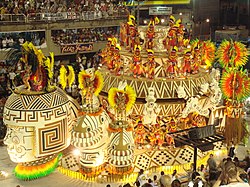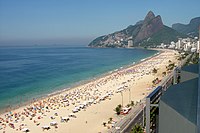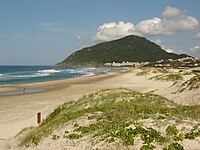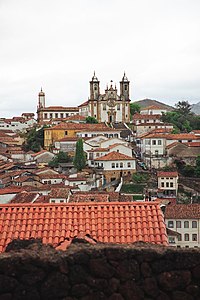This is an old revision of this page, as edited by 189.105.166.6 (talk) at 15:20, 20 October 2008 (→Domestic tourism). The present address (URL) is a permanent link to this revision, which may differ significantly from the current revision.
Revision as of 15:20, 20 October 2008 by 189.105.166.6 (talk) (→Domestic tourism)(diff) ← Previous revision | Latest revision (diff) | Newer revision → (diff)

Tourism in Brazil is a growing sector and key to the economy of several regions of the country. The country had 5.026 million visitors in 2007, placing Brazil as the fourth largest tourist destination in the Americas, the main destination in South America, and second in Latin America after Mexico, in terms of the international tourist arrivals. Revenues from international tourists reached USD 4.95 billion in 2007. In 2005, tourism contributed with 3.2% of the country's revenues from exports of goods and services, and represented 7% of direct and indirect employment in the Brazilian economy. In 2006 direct employment in the sector reached 1.87 million people. Domestic tourism is a fundamental market segment for the industry, as 51 million travel throughout the country in 2005, and direct revenues from Brazilian tourist reached USD 21.8 billion, 5.6 times more receipts than international tourists in 2005.
Brazil offers for both domestic and international tourists, an ample gamut of options, with natural areas being its most popular tourism product, a combination of ecotourism with leisure and recreation, mainly sun and beach, and adventure travel, as well as historic and cultural tourism. Among the most popular destinations is the Amazon Rainforest, beaches and dunes in the Northeast Region, the Pantanal in the Center-West Region, beaches at the Rio de Janeiro and Santa Catarina, cultural and historic tourism in Minas Gerais and business trips to São Paulo city.
In terms of 2008 Travel and Tourism Competitiveness Index (TTCI), which is a measurement of the factors that make it attractive to develop business in the travel and tourism industry of individual countries, Brazil reached the 49th place in the world's ranking, second among Latin American countries, and sixth in the Americas. Brazil main competitive advantages are shown by the subindex measuring human, cultural, and natural resources, where Brazil ranks sixth at the worldwide level, and third when only the natural resources criteria is considered. The TTCI report also notes Brazil's main weaknesses, information and communications technology infrastructure (ranked 58th), ground transport infrastructure (ranked 95th), and safety and security (ranked 128th).
International tourism
| Historial international tourism arrivals 1995-2007 | ||||
|---|---|---|---|---|
| Year | International tourist arrivals (x1000) |
Anual growth (%) |
Total revenue (millions USD) |
Anual growth (%) |
| 1995 | 1.991 | - | 972 | - |
| 2000 | 5.313 | - | 1.810 | - |
| 2003 | 4.133 | - | 2.479 | - |
| 2004 | 4.794 | 16,0 | 3.222 | 30,0 |
| 2005 | 5.358 | 11,8 | 3.861 | 19,8 |
| 2006 | 5.019 | -6,3 | 4.316 | 1,1 |
| 2007 | 5.025 | 0,1 | 4.953 | 14,8 |




According to the World Tourism Organization (WTO), international travel to Brazil began to grow fast since 2000, paricullarly during 2004 and 2005. However, in 2006 a slow down took place, and international arrivals kept almost constant in 2007. In spite of this trend, revenues from international tourism continue to rise, from USD 3.9 billion in 2005 to USD 4.9 billion in 2007, a one billion dollar increase despite 333 thousand less arrivals. This favorable trend is the result of the strong devaluation of the American dollar against the Brazilian Real, which began in 2004, but on the other hand, making Brazil a more expensive international destination. Also, there have been a market demand contraction of international visitors due the 2006-2007 Brazilian aviation and airport crisis, and Varig Brazilian airline financial crisis, considered responsible for close to 400 thousand international travelers desisting to visit Brazil in 2006.
Despite continuing record breaking of international tourism revenues, the number of Brazilian tourists travelling overseas has been growing steadily since 2003, resulting in a net negative foreign exchange balance, as more money is spent abroad by Brazilian than receipts from international tourist visiting Brazil. Tourism expenditures abroad grew from USD 5.76 billion in 2006, to USD 8.21 billion in 2007, a 42,45% increase, representing a net deficit of USD 3.26 billion in 2007, as compared to USD 1.45 billion in 2006, a 125% increase from the previous year. This trend is caused by Brazilians taking advantage of the stronger Real to travel and making relatively cheaper expenditures abroad. Brazilian traveling overseas in 2006 represented 3.9% of the country's population.
In 2005, Rio de Janeiro, Foz de Iguaçu, São Paulo, Florianópolis and Salvador were the most visited cities by international tourists for leisure trips. The most popular destinations for business trips were São Paulo, Río de Janeiro and Porto Alegre. In 2006 Rio de Janeiro and Fortaleza were the most popular destinations by national visitors.
| Main destinations visited by international tourists in 2005 Top 10 ranking by travel purpose | ||||||||
|---|---|---|---|---|---|---|---|---|
| Leisure | Business events & conventions |
Other purposes | ||||||
| Ranking (2005) |
Destination | % | Ranking (2005) |
Destination | % | Ranking (2005) |
Destination | % |
| 1º | Rio de Janeiro | 31,5 | 1º | São Paulo | 49,4 | 1º | São Paulo | 32,5 |
| 2º | Foz de Iguaçu | 17,0 | 2º | Rio de Janeiro | 22,3 | 2º | Rio de Janeiro | 25,0 |
| 3º | São Paulo | 13,6 | 3º | Porto Alegre | 8,2 | 2º | Belo Horizonte | 6,4 |
| 4º | Florianópolis | 12,1 | 4º | Curitiba | 5,4 | 4º | Salvador | 6,3 |
| 5º | Salvador | 11,5 | 5º | Belo Horizonte | 4,1 | 5º | Foz de Iguaçu | 5,1 |
| 6º | Balneário Camboriú | 6,7 | 6º | Campinas | 4,1 | 6º | Curitiba | 4,6 |
| 7º | Fortaleza | 6,4 | 7º | Brasília | 3,4 | 7º | Florianópolis | 4,0 |
| 8º | Natal | 5,8 | 8º | Foz de Iguaçu | 3,0 | 8º | Porto Alegre | 3,6 |
| 9º | Armação dos Búzios | 5,4 | 9º | Salvador | 2,7 | 9º | Fortaleza | 3,4 |
| 10º | Manaus | 4,0 | 10º | Florianópolis | 1,8 | 10º | Brasília | 3,1 |
Most international visitor in 2007 came from Argentine (18.3%), from the United States (13,9%) and from Portugal (5.6%), but Europeans as whole represent 39.7% of all visitors, the same share as visitors from neighboring South American countries, mainly from Mercosur. Top international arrivals by country of origin in 2006 and 2007 are:
| Top 15 visitor arrivals to Brazil by country of origin (2006-2007) | |||||
|---|---|---|---|---|---|
| Ranking 2007 |
Country of origin |
Foreign tourists 2007 |
% total |
Foreign tourists 2006 |
% total |
| 1º | 920.210 | 18,31 | 933.061 | 18,63 | |
| 2º | 699.169 | 13,91 | 721.633 | 14,41 | |
| 3º | 280.438 | 5,58 | 299.211 | 5,97 | |
| 4º | 268.685 | 5,35 | 287.898 | 5,75 | |
| 5º | 260.430 | 5,18 | 167.357 | 3,34 | |
| 6º | 257.719 | 5,13 | 277.182 | 5,53 | |
| 7º | 254.367 | 5,06 | 275.913 | 5,51 | |
| 8º | 226.111 | 4,50 | 255.349 | 5,10 | |
| 9º | 216.373 | 4,31 | 211.741 | 4,23 | |
| 10º | 206.323 | 4,11 | 198.958 | 3,97 | |
| 11º | 176.948 | 3,52 | 169.627 | 3,39 | |
| 12º | 96.336 | 1,92 | 64.002 | 1,28 | |
| 13º | 83.554 | 1,66 | 86.122 | 1,72 | |
| 14º | 72.763 | 1,45 | 84.816 | 1,69 | |
| 15º | 63.963 | 1,27 | 62.603 | 1,25 | |
| International visitor arrivals by region of origin (2007 and 2006) | |||||
| South America | 1,906,451 | 37,9 | 1,818,352 | 36,2 | |
| Europe | 1,906,078 | 37,9 | 1,951,528 | 38,9 | |
| North America | 821,921 | 16,4 | 855,098 | 17,0 | |
Comparison with other Latin American destinations
The following is a comparative summary of Brazil's tourism industry key performance indicators as compared with countries considered among the most popular destinations in Latin America, and relevant economic indicators are included to show the relative importance that international tourism has on the economy of the selected countries.
| Selected Latin American countries |
Internl. tourism arrivals 2007 (x 1000) |
Internl. tourism receipts. 2007 (USD millions) |
Average receipt per visitor 2007 (USD/turista) |
Tourist arrivals per 1000 inhab (estimated) 2007 |
Receipts per capita 2005 USD |
Revenues as % exports of goods and services 2003 |
Tourism income % GDP 2003 |
% Direct and indirect employment in tourism 2005 |
World ranking Tourims Competitiv. TTCI 2008 |
2008 TTCI Index |
|---|---|---|---|---|---|---|---|---|---|---|
| 4,562 | 4,313 | 945 | 115 | 57 | 7,4 | 1,8 | 9,1 | 58 | 4,17 | |
| 5,026 | 4,953 | 985 | 26 | 18 | 3,2 | 0,5 | 7,0 | 49 | 4,29 | |
| 2,507 | 1,419 | 566 | 151 | 73 | 5,3 | 1,9 | 6,8 | 51 | 4,27 | |
| 1,973 | 1,974 | 1.001 | 442 | 343 | 17,5 | 8,1 | 13,3 | 44 | 4,35 | |
| 2,119 | 1,982 | 935 | 188 | 169 | n/d | n/d | n/d | n/d | n/d | |
| 3,980 | 4,026 | 1,012 | 408 | 353 | 36,2 | 18,8 | 19,8 | 63 | 4,05 | |
| 21,424 | 12,901 | 602 | 201 | 103 | 5,7 | 1,6 | 14,2 | 55 | 4,18 | |
| 1,103 | 1,185 | 1,074 | 330 | 211 | 10,6 | 6,3 | 12,9 | 50 | 4,29 | |
| 1,812 | 1,938 | 1,070 | 65 | 41 | 9,0 | 1,6 | 7,6 | 70 | 3,87 | |
| 1,752 | 809 | 462 | 525 | 145 | 14,2 | 3,6 | 10,7 | 61 | 4,10 |
- Note : The background green shadow denotes the country with the best indicator and y yellow shadow corresponds to Brazil indicators.
Domestic tourism
Domestic tourism is a key market segment for the tourism industry in Brazil. In 2005, 51 million Brazilian nationals made ten times more trips than foreign tourists and spent five times more money than their international counterparts. The main destination states in 2005 were São Paulo (27,7%), Minas Gerais (10,8%), Rio de Janeiro (8,4%), Bahia (7,4%) and Santa Catarina (7,2%). The top three state by trip origin were São Paulo (35,7%), Minas Gerais (13,6%) and Rio de Janeiro (8,2%). In terms of tourism revenues, the top earners by state are São Paulo (16,4%) and Bahia (11,7%). For 2005 the three main trip purposes were visiting friends and family (53,1%), sun and beach(40,8%), and cultural tourism(12,5%).
Tourism by regions of Brazil
Southeast Region




- Rio de Janeiro
- Rio de Janeiro State: Angra dos Reis, Paraty, Resende, Visconde de Mauá, Itatiaia National Park, Petrópolis, Vassouras, Teresópolis, Serra dos Órgãos, Nova Friburgo, Saquarema, Arraial do Cabo, Cabo Frio, Búzios, Ilha Grande
- Espírito Santo: Vitória, Guarapari, Anchieta, Piúma, Domingos Martins, Santa Teresa
- Minas Gerais: Belo Horizonte, Sabará, Ouro Preto, Congonhas, Mariana, Lavras, São João del Rei, Tiradentes, Diamantina, Caxambu, São Lourenço, São Thomé das Letras, Caparaó National Park, Pico da Bandeira, Serra do Cipó National Park
- São Paulo
- São Paulo State: São Sebastião, Ilhabela, Boiçucanga, Guarujá, Santos, Iguape, Cananéia, Campos do Jordão
Southern Region
- Paraná: Curitiba, Morretes, Antonina, Paranaguá, Ilha do Mel, Superagüi National Park, Foz do Iguaçu, Iguaçu Falls
- Santa Catarina: Florianópolis, Ilha de Santa Catarina, Joinville, Blumenau
- Rio Grande do Sul: Porto Alegre, Torres, Aparados da Serra National Park, Serra Gaúcha, Canela, Gramado
Center-West Region
- Distrito Federal: Brasília
- Goiás: Goiânia, Chapada dos Veadeiros National Park, Pirenópolis, Goiás Velho, Caldas Novas, Emas National Park, Araguaia River
- Mato Grosso: Cuiabá, The Pantanal, Chapada dos Guimarães National Park, Barra do Garças, Alta Floresta, Cáceres, Barão de Melgaço, Poconé
- Mato Grosso do Sul: Campo Grande, Corumbá, Bonito, Ponta Porã, Aquidauana, Coxim, Jardim
Northeast Region
- Bahia: Salvador, Cachoeira, Lençóis, Morro de São Paulo, Ilhéus, Porto Seguro, Arraial d'Ajuda, Trancoso, Chapada Diamantina National Park, Abrolhos Marine National Park
- Pernambuco: Recife, Olinda, Itamaracá, Igarassu, Caruaru, Fazenda Nova, Nova Jerusalém, Garanhuns, Triunfo, Fernando de Noronha
- Ceará: Fortaleza, Aracati, Canoa Quebrada, Jericoacoara, Tatajuba, Camocim, Sobral, Baturité, Ubajara National Park, Juazeiro do Norte
- Sergipe: Aracaju, Laranjeiras, São Cristóvão, Estância, Propriá
- Alagoas: Maceió, Penedo
- Paraíba: João Pessoa, Baía da Traição, Sousa
- Rio Grande do Norte: Natal
- Piauí: Teresina, Sete Cidades National Park, Parnaíba, Serra da Capivara National Park
- Maranhão: São Luís, Lençóis Maranhenses National Park, Alcântara, Imperatriz, Carolina
North Region
- Amazonas: Manaus, Parintins, Tefé, Mamirauá
- Pará: Belém, Ilha de Marajó, Santarém
- Tocantins: Palmas, Ilha do Bananal, Natividade
- Amapá: Macapá, Oiapoque
- Roraima: Boa Vista, Monte Roraima
- Rondônia: Porto Velho, Guajará-Mirim, Guaporé Valley
- Acre: Rio Branco, Xapuri, Brasiléia, Assis Brasil
References
- ^ World Tourism Organization (2008). "UNWTO World Tourism Barometer June 2008" (PDF). UNWTO. Retrieved 2008-08-08. Data corresponds to 2007
- The World Tourism Organization. "Tourism Highlights 2006 [pdf]" (PDF). Retrieved 2006-01-06.
- ^ Carmen Altés (2006). "El Turismo en América Latina y el Caribe y la experiencia del BID" (in Spanish). Inter-American Development Bank; Sustainable Development Department, Technical Paper Series ENV-149, Washington, D.C. p. 9 and 47. Retrieved 2008-06-14.
{{cite web}}: Cite has empty unknown parameter:|1=(help) Cite error: The named reference "BID2006" was defined multiple times with different content (see the help page). - Margerida Coelho (2008). "Distribução Espacial da Ocupação no Setor de Turismo: Brasil e Regiões" (PDF) (in Portuguese). Instituto de Pesquisa Econômica Aplicada. Retrieved 2008-06-22.
- ^ Fundação Instituto de Pesquisas Econômicas (2007). "Caracterização e Dimensionamento do Turismo Domêstico no Brasil 2002 e 2006" (PDF) (in Portuguese). Ministério do Turismo. Retrieved 2008-06-21.
- ^ Jennifer Blanke and Thea Chiesa, Editors (2008). "The Travel & Tourism Competitiveness Report 2008" (PDF). World Economic Forum, Geneva, Switzerland. Retrieved 2008-06-14.
{{cite web}}:|author=has generic name (help) Cite error: The named reference "TTCI2008" was defined multiple times with different content (see the help page). - World Economic Forum (2008-03-06). "Country/Economy Profiles: Brazil". The Travel & Tourism Competitiveness Report 2008. Retrieved 2008-06-14.
- ^ World Tourism Organization (2005). "Tourism Market Trends, Annex 5, 2005 Edition" (PDF). Retrieved 2008-03-30.
- ^ World Tourism Organization (2006). "Tourism Market Trends, Annex 12, 2006 Edition" (PDF). Retrieved 2008-03-30.
- ^ World Tourism Organization (2007). "UNWTO Tourism Highlights, Edition 2007" (PDF). UNWTO. Retrieved 2008-06-14.
{{cite web}}: CS1 maint: date and year (link) - ^ EMBRATUR (2008). "Principais Emissores de Turistas para o Brasil 2006-2007" (in Portuguese). Ministério de Turismo. Retrieved 2008-06-19.
- Facultade Getúlio Vargas (2008). "Boletim de Desempenho Econômico do Turismo" (in Portuguese). Ministério de Turismo. Retrieved 2008-06-19. Janeiro 2008, Ano v, nº 17, pp. 2
- Facultade Getúlio Vargas (2007). "Boletim de Desempenho Econômico do Turismo" (PDF) (in Portuguese). Ministério de Turismo. Retrieved 2008-06-21. Fevereiro 2007, Ano IV, nº 13, pp. 3
- ^ Facultade Getúlio Vargas (2008). "Pesquisa Anual de Conjuntura Econômica do Turismo" (PDF) (in Portuguese). Ministério de Turismo. Retrieved 2008-06-22. Março 2008, Ano IV, pp. 11
- ^ Fundação Instituto de Pesquisas Econômicas e EMBRATUR (2006). "Caracterização e Dimensionamento do Turismo Domêstico no Brasil 2002 e 2006: Metodologia e Desenvolvimento" (PDF) (in Portuguese). Ministério do Turismo. Retrieved 2008-06-22.
- ^ EMBRATUR (2006). "Anúario Estatístico Volume 33 2006" (PDF) (in Portuguese). Ministério do Turismo. Retrieved 2008-06-22. Tables 4.1 a 4.4: Summary Brasil by trip purpose 2004-2005
- ^ EMBRATUR (2008). "Anuário estatístico 2008" (PDF). Ministério de Turismo. Retrieved 2008-06-19. Table 1.1: Tourist Arrivales to Brazil
- United Nations. "UNData. Country profiles". Retrieved 2008-08-08. Population estimates for 2007 (search on each country profile)
- World Tourism Organization (2006). "Tourism Market Trends, Annex 12, 2006 Edition" (PDF). Retrieved 2008-03-30.
| |||||||||||||||||||||||||||||||||||||||||||||||||||
| Related topics | |||||||||||||||||||||||||||||||||||||||||||||||||||
| Brazil articles | |||||||
|---|---|---|---|---|---|---|---|
| History | |||||||
| Geography | |||||||
| Politics | |||||||
| Economy |
| ||||||
| Society |
| ||||||
| Tourism in South America | |
|---|---|
| Sovereign states | |
| Dependencies and other territories | |